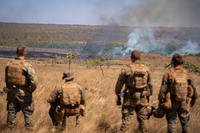It was 1942 during the allied assault on French Morocco. Fireman 1st Class Paul Leaman Clark was a landing boat engineer attached to the USS Joseph T. Dickman supervising the unloading of soldiers and supplies from the transports on the beach.
Early into the assault, Clark was unloading a transport when his boat was battered with machinegun fire; the bowman was mortally wounded and the coxswain was severely injured. Despite the perilous conditions, Clark took control of the boat and withdrew from the beach with the injured crewmember aboard.
Clark was one of six Coast Guardsman awarded the Navy Cross for actions during WWII, and his bravery and legacy will live on with the service’s newest fast response cutter – Coast Guard Cutter Paul Clark.
Lt. W. W. Lloyd Belcher is the ship’s commanding officer and reflected on the importance of honoring the memory of those who served, including his own grandfather, William Lloyd, who served on B-24 Liberators.
Belcher recalls his grandfather spoke little of his experiences during the war, other than to comment on the camaraderie of his fellow soldiers and the dedication they had to each other.
“Like all of my shipmates, we are humbled daily when we think of the sacrifices made by the long blue line of Coasties and other veterans who have served, particularly those citizen-heroes from WWII,” said Belcher. “While it is a heavy burden to carry on such an incredible legacy, this crew is more than willing to shoulder it and do our part.”
Part of carrying on Clark’s legacy is recognizing how truly heroic his actions were in taking the helm after his coxswain was injured, despite his training as an engineer.
“The fact that he was an engineer demonstrates that we are more than just our rating. Engineers have always been key players in Coast Guard missions, even outside of the engine room,” said Petty Officer 1st Class Luis Rivera, an electrician’s mate aboard Cutter Paul Clark. “His example gives us a legacy to be proud of.”
Clark’s heroism is also a point of inspiration for the cutter’s junior plankowners. Petty Officer 3rd Class Darian Suprun, a machinery technician, didn’t know much about Clark when she first received orders to the fast response cutter. After some research, she was “amazed” at what he had accomplished.
“The fact that he was just a fireman, and probably had even less experience in small boats than I do, it’s just impressive,” said Suprun. ‘It reminds us all to step up and look to do more, no matter how junior we may be.”
It’ll be a team effort as Cutter Paul Clark’s crew sets out on their first operational missions; missions that include port, waterways and coastal security; fishery patrols; search and rescue; and national defense.
Cutter Paul Clark also has fully interoperable command and control systems with Homeland Security and Department of Defense assets.
“The capabilities and efficiencies built into the fast response cutters are going to be game changers here in the 7th District,” said Belcher.
“We’re finally getting the tools we need to succeed without having to worry about spending all that time on maintenance and repair that the old ships required,” added Chief Petty Officer Brian Berryhill who previously served on buoy tenders built in the 1940s and medium endurance cutters built in the 1960s.
But it’s not just about the newest technology; it’s about the crew who will embody Clark’s spirit of getting the mission done.
"As a plankowner, you really have the chance to set a high standard from the very beginning, one that all the future crews will follow,” said Petty Officer 2nd Class George Corriere. “As the first gunner’s mate on the ship, I don’t have any previous example to follow. It’s all on us to make sure we do it right the first time.”























